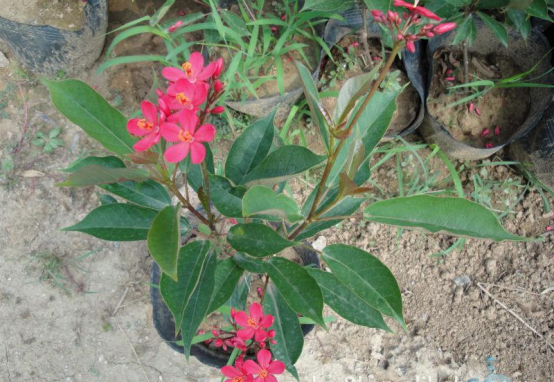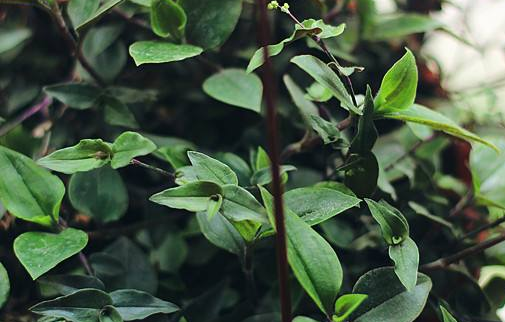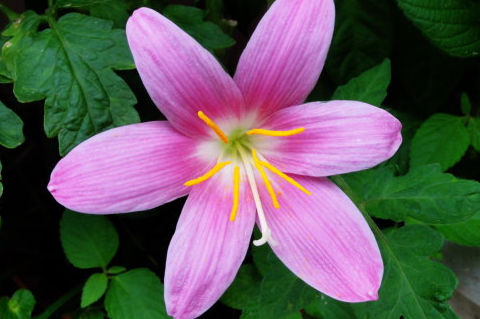Culture methods and matters needing attention of Qin Leaf Coral
1. Temperature
Humid tropical plants like the high temperature environment, so it is best to maintain a temperature of 26-28 degrees, which is the most suitable temperature for the growth of the corals, but the corals are not hardy and need to keep the temperature above 12 degrees through the winter, otherwise there is a risk of frostbite. So flower friends in the north, if you want to raise viola leaf coral, you should pay attention to keep the growth temperature of violin leaf coral not too low in winter.
two。 Soil
The demand for soil is not high.
Like acidic, sandy, loose, fertile, organic matter-rich soil.
3. Watering
Qin Ye Coral likes a humid environment and is not resistant to drought, so flower friends live in the north. The editor suggests that you can not consider this plant for the time being, but just because you like a humid environment does not mean that you can accumulate water, so you must pay attention to the use of flowerpots and soil to be loose and ventilated.

4. Sunshine
Like the warm, dry, sunny growth environment, so, at noon in summer, remember to find a shady place for Qin Ye Coral, even if you like the sun, you will not want to be exposed to the hot sun, so you will get sunburn.
5. Pruning
Qin leaf coral can also be used as a pot conservation, it is a kind of shrub flowers, but the plant is erect, and the plant type can be controlled at more than one meter in the potted plant. Regular pruning can also promote continuous differentiation, which is conducive to the formation of more buds and better ornamental.
Culture methods and matters needing attention of Qin Leaf Coral
The temperature that the corals like
Qin Ye coral likes the high temperature environment, so it is best to maintain a temperature of 26-28 degrees. The temperature in this range is the most suitable temperature for its growth, but it is not hardy, and it needs to maintain a temperature above 12 degrees through the winter. Otherwise, there is a risk of frostbite and death. So flower friends in the north, if you want to raise violin leaf corals, you should be careful!
The soil that Qin Ye Coral likes
Soil that is acidic, sandy, loose, fertile and rich in organic matter. Breaking apart one by one, I don't know if you see it a little more clearly.
The moisture that the corals like
Qin Ye Coral likes the wet environment and is very afraid of drought, so if you are from the north, you can ignore this plant for the time being, but just because you like the humid environment does not mean that he will like stagnant water, so you must pay attention to the use of flowerpots and soil to be loose and ventilated.
The sunshine that Qin Ye coral likes
Warm, dry, plenty of sunshine, so, at noon in summer, remember to find a shady place for Qin Ye Coral, even if you like the sun, you will not want to receive the hot sun, so you will get sunburn.
The mode of reproduction of harp leaf corals
Qin leaf corals are generally propagated by cuttings, usually in spring.
Jatropha integerrima Jacq. Photo of Qin Ye coral: how to raise Qin Ye coral / how to breed Qin Ye coral name card Qin Ye coral Jatropha integerrima Jacq. Introduction to the culture methods and matters needing attention of Qin leaf coral the alias of Qin leaf coral changed into leaf coral flower, piano leaf cherry, Nanyang cherry, Japanese cherry, Euphorbiaceae Euphorbiaceae leprosy tree genus, for evergreen shrubs, red flowers, plants have milk, milk poisonous. It is native to the West Indies and is cultivated in southern China. The Corolla of Qin Leaf Corolla is red and blossoms all year round, and each flower blossoms for a long time, so it can be seen throughout the year and looks like a cherry blossom, so it is also known as "daily cherry". Because its leaf shape is similar to the piano, it is known as the piano leaf cherry; and it looks like a cherry blossom, so it is called the daily cherry, and the other name Nanyang Sakura is because it was introduced from Nanyang. Violaceae coral belongs to Euphorbiaceae, which is native to Central America and is cultivated in the south of China. Plant toxic milk is poisonous and should not be eaten by mistake. Accidental contact with milk causes blisters or pustules, the skin is seriously inflamed, and it is also very toxic to the eyes; livestock mistakenly eat fallen leaves, often causing serious blistering in the mouth. First aid method: vomiting and washing with water. The biological characteristics of the corals are as follows: the stem is about 1-2 meters high; the leaves are alternate, obbroad-lanceolate, often clustered at the top of the branches. The leaf base has 2-3 pairs of sharp thorns, the leaf tip is acuminate, the leaf surface is dark green, the back of the leaf is purple-green, the petiole is fluffy, the leaf surface is smooth; Cymes, petals 5, Corolla red; and unisexual flowers, monoecious, born on different inflorescences, and pink varieties; the capsule is dark brown at maturity. Stem: the plant height is about 1-2 meters. Leaves: simple leaves alternate, obbroad-lanceolate, often clustered at the top of branches. The leaf base has 2-3 pairs of sharp thorns, the leaf tip is acuminate, the leaf surface is dark green, the leaf back is purplish green, the petiole is fluffy, the leaf surface is smooth. Flowers: Cymes, 5 petals, Corolla red, like cherry blossoms; and unisexual flowers, monoecious, born on different inflorescences; other pink varieties. Florescence: spring to autumn. Fruit: the capsule is dark brown when mature. Leaves papery, alternate, various in shape, ovate, Obovate, oblong or violin-shaped, 4-8cm long and 2.5-4.5cm wide, apex acute or acuminate, base obtusely rounded, often with several sparse cusps near basal margin, purplish red below young leaves; stipules small, caducous. Dioecious. Cymes terminal, red, flowers unisexual, calyx lobes 5, petals long elliptic, with disk; male flowers: stamens 10, two whorls, outer filaments slightly connate, inner filaments connate to middle. Female flowers are slightly larger than male flowers, ovary glabrous, styles 3, basally connate, stigmas 2-lobed. The ecological habits of Qin leaf corals prefer high temperature and humidity, and are afraid of cold and dryness, and should be kept above 12 ℃ in winter. Like sufficient light, slightly resistant to half-shade; like to grow in loose, fertile, acidic sandy soil rich in organic matter. Therefore, Qinye coral is more suitable to grow in Shenzhen. The distribution area of harp leaf coral is native to the West Indies and is often cultivated in the south of China. When the light is insufficient, it is easy to produce more leaves and less flowers. Japanese cherry, which is native to West India, is very similar to Taiwan, so it adapts very well, and is widely used in the landscape. Cultivation techniques of Chimonanthus angustifolia Corals like warm, dry and sufficient sunlight. Family cultivation should not be placed in places lacking direct sunlight. The suitable temperature for growth is 26-28 ℃. If it is below 10 ℃, it is easy to shed leaves but can still bloom. The common method of propagation of harp-leaf coral is cuttage, which is carried out in spring. Chin leaf coral is an excellent ornamental flower in the courtyard. The results of cutting experiment showed that hardwood cutting had high survival rate, more main roots and root length, and the cuttings were treated with CPD rooting powder 400 mg/kg, river sand was used as cutting medium, and the branches were spread for 16 days and then cut into ear cuttings. The role of Qin leaf coral ornamental value throughout the year, blooming flowers, are red or pink, quite ornamental. Although the flower is not large, it has a long flowering period. It can be seen blooming at any time. It is a common ornamental flower in the garden and is widely used in the landscape. Suitable for planting in the house or large potted plants. As one of the plants to purify the air, incense the environment, afforest the city and beautify the courtyard, the violin coral plays an important role in the landscaping of our country. With the development of economy, people's demand for landscaping is increasing, and viola coral is more and more widely used. Because of its beautiful leaves, gorgeous flowers, long florescence, easy reproduction and maintenance, it is widely used in gardens. Qin leaf coral is mainly used for garden planting or large potted flowers, although it is not large, because of its long flowering period, it can be seen to bloom at any time. It is a common ornamental flower in the garden and is widely used in the landscape. Propagation is carried out by cutting in spring. Shenzhen Bay Park is planted in a large area, as well as some other parks and municipal roads. Members of the public can go to see it. Pictures of violin leaf coral
- Prev

Breeding methods of wedding gown orchids
1. If the cuttage is propagated by cutting, the rhizome of the new bud between 5 cm and 10 cm can be inserted into the soil, and the root system can be formed in about a week, and can be planted when it grows to about 20 days, because the wedding dress hanging orchid is more adaptable.
- Next

Culture method of leek lotus
1. Soil leek lotus has strong adaptability to soil and is suitable to grow in sandy soil rich in humus. two。 The temperature of leek lotus likes the warm environment, the suitable temperature for its growth is 16-28 ℃, it is not hardy, and the winter temperature should not be lower than 5 ℃. 3. The light shines on the leek lotus like the sun, and it is also more resistant to semi-overcast.
Related
- Fuxing push coffee new agricultural production and marketing class: lack of small-scale processing plants
- Jujube rice field leisure farm deep ploughing Yilan for five years to create a space for organic food and play
- Nongyu Farm-A trial of organic papaya for brave women with advanced technology
- Four points for attention in the prevention and control of diseases and insect pests of edible fungi
- How to add nutrient solution to Edible Fungi
- Is there any good way to control edible fungus mites?
- Open Inoculation Technology of Edible Fungi
- Is there any clever way to use fertilizer for edible fungus in winter?
- What agents are used to kill the pathogens of edible fungi in the mushroom shed?
- Rapid drying of Edible Fungi

